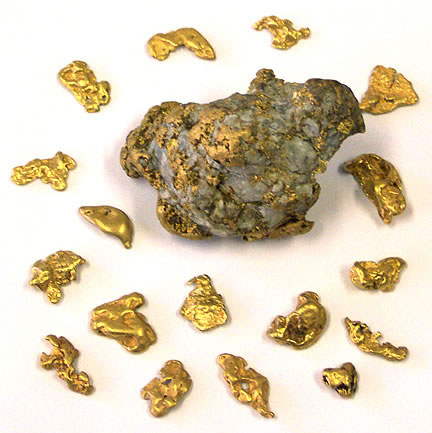
Calcium Peroxide to Gold Cyanide Leaching
Definition
Gold cyanidation (also known as the cyanide process or the MacArthur-Forrest
Process) is a metallurgical technique for extracting gold from low-grade
ore via the use of cyanide compounds. It is at present the most important
and most-often used process for this purpose. Due to the highly toxic
 nature
of cyanide, the process is controversial.
nature
of cyanide, the process is controversial.
The reaction
CaO2 + 2H2O → Ca(OH)2 +H2O2
2H2O2 → 2H2O + O2
2Au + 4NaCN + O2 + 2H2O → 2NaAu(CN)2 + 2NaOH + H2O2
4Au + 8NaCN + O2 + 2H2O → 4NaAu(CN)2 + 4NaOHEffect of Dissolved Oxygen
Oxygen is one of the reagents consumed during cyanidation, and a deficiency in dissolved oxygen in solution can slow leaching kinetics. Air or oxygen gas can be bubbled through the pulp to increase the dissolved oxygen concentration. Intimate oxygen-pulp contactors can be used to increase the partial pressure of the oxygen in contact with the solution, thus raising the dissolved oxygen concentration much higher than the saturation level at atmospheric pressure. Oxygen can also be added by dosing hydrogen peroxide solution, while calcium peroxide is used as assisting agent to speed up the reaction.
Benefit of using Calcium Peroxide
Additions of calcium peroxide may vary from 0.1 to 5.0 kg/t, more preferably from 0.1 to 2.0 kg/t, yet more preferably from 0.1 to 1.0 kg/t (calculated on the basis of 100% calcium peroxide) depending on the nature of the ore. For example, the amount used depends on whether the ore contains silver or silver and gold, or silver, gold and other precious metals, the mineralogy of the sample etc. Upper limits of calcium peroxide addition are determined by pH effects and process economics.
The contact time between the ore to be treated and the calcium peroxide may vary between 8 to 60 hours .
The calcium peroxide may be added to the ore treatment circuit at any point from the grinding to the leaching stage. Thus calcium peroxide may be introduced into the circuit at any point where standard lime addition may be made, for example, in grinding or into Merrill Crowe or into the CIP/CIL (carbon in pulp/carbon in leach) stage.
Generally speaking, the addition of calcium peroxide improves cyanide utilization. The amount of lime added to the circuit for pH control will be reduced or eliminated altogether in some cases, depending on the addition rate of calcium peroxide and the amount of free lime usually associated with commercial grades of calcium peroxide.
We have found that in the process according to the invention calcium peroxide is a much more stable compound as compared with hydrogen peroxide, releasing oxygen at a controlled rate over much longer time periods. As a result, process monitoring requirements are not as stringent as are required for hydrogen peroxide. Furthermore, reagent consumption is generally lower because of the more efficient utilisation of the available oxygen.
Calcium peroxide does not catalyse the degradation of cyanide. In fact the reduction in cyanide consumption is up to 25%, even though precious metal recoveries are increased. In summary, the principal benefits in using calcium peroxide when compared to alternative processes are:
Learn more about calcium peroxide
Download
![]() Specification
Data Sheet (Fine Powder Form 75% grade)
Specification
Data Sheet (Fine Powder Form 75% grade)
Specification
Data Sheet (Fine Powder Form 60% grade)
Specification
Data Sheet (Granlues / Sinking Solid Form)
Material Safety Data Sheet
